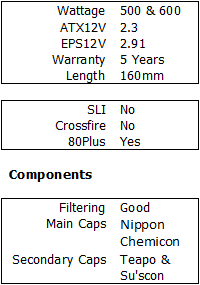Cooler Master Silent Pro PSUs
by Christoph Katzer on September 8, 2008 3:00 AM EST- Posted in
- Cases/Cooling/PSUs
Conclusion
The Cooler Master Silent Pro series is not available in the U.S. yet, but we do hope that the legal issues over cable management will be settled soon. That would allow this great product to find its way to the states as well Europe. The overall performance is great, it looks good, and it comes with some nice features. Packaging might influence some people when it comes to buying parts, but the build quality is where this product really shines. This Enhance unit shows a good choice of components like the Nippon Chemi-Con capacitors.
 |
The cables are a little short but should be fine for most medium towers with the PSU mounted in the top section. For a moderate setup with up to two midrange GPUs or a single high-end GPU, this power supply will be a good choice. You can connect any card with one or two PEG jacks on it, since both 6-pin and 8-pin PEG connections are supported. Dual GPUs can only require a single PEG connector, but that makes sense for a 500W or 600W PSU.
In the important performance area, there were a few surprises. The difference between the two otherwise identical seeming models was one surprise, as we expected only minor variations. The real difference between the two units is not really the maximum efficiency but rather the difference in the efficiency curves. While the 500W version performs similar to what we've seen in the past, the 600W version is very efficient at low to medium loads after which it goes quickly downhill. With either unit, optimal performance will come with loads of 130W to 300W - perfect for systems with a single high-end graphics card or a couple midrange cards. As for the DC output stability, the 12V rail is exceptionally stable, but the lower voltage rails showed moderate drops - around 5% regulation on the 3.3V and 3% on the 5V rails. The quality in terms of ripple and noise is well within spec, so there's no concern there. The acoustic levels have been phenomenal and stayed well below 20dB(A) even at the highest loads. However, temperatures were increasing quickly and we don't actually recommend using these units in hot environments combined with high loads.
Pricing is often the critical factor, and we see prices of €80 for the 500W version and €90 for the 600W model. That might soon be $116 and $130 for US customers, provided Cooler Master can overcome the legal obstacles. In addition, Cooler Master also has a 700W model priced at €110/$160. If you want good performance and a quiet computer, we're happy to report that the Cooler Master Silent Pro series manages to live up to its name. These PSUs are definitely worth a look if you live in Europe.










15 Comments
View All Comments
ryboto - Wednesday, September 17, 2008 - link
You're quite incorrect. The method for heat transfer from the heatsinks to the air is the same for both copper and aluminum. If you took a heat transfer course you'd know that the thermal conductivities and convective heat transfer coefficients are what is used in the heat transfer equations. No where is it dependent on the heat capacity. So, you haveQ=K A (Tb-Th) where Tb=base temp, Th= heatsink temp, then heat transfer to the air is
Qa=h A (Th-Ta) where Ta is the bulk air temp. These are highyl approximated, as there are multiple layers. Now, look at the equations...if K for Cu is greater than for Al, heat transfer is faster. What this amounts to is a greater Th, but look at the second equation, if Th is greater, the temperature gradient(or driving force for heat transfer) is greater than it would be for aluminum. Copper is a better material for this application. It's just expensive, and it oxidizes, which is why we have nickel plated copper heatpipes.
Megaknight - Tuesday, September 9, 2008 - link
Great explanation mate.Penti - Monday, September 8, 2008 - link
It's an old tale but it's just that a tale.Weight has probably a lot to do with it on modern coolers, I have a Tuniq Tower 120, think of this cooler in pure copper, it would snap the motherboard with it's weight probably. We haven't moved to coolers weighing 2-3 kg yet. But as always price is the main factor.
Aquila76 - Monday, September 8, 2008 - link
'Transfer' and 'dissipate' are different things. The copper plates transfer heat away from the components better; the aluminum fins dissipate (exchanges may have been a better word choice there) the heat into the air. This is not unlike those heatpipe tower-style CPU coolers.Christoph Katzer - Monday, September 8, 2008 - link
Thanks mate.